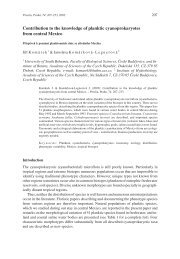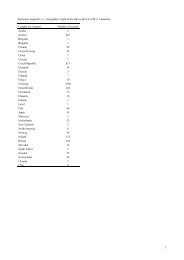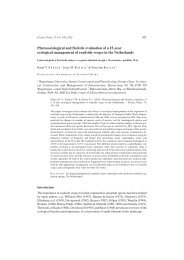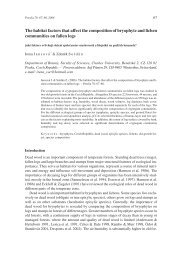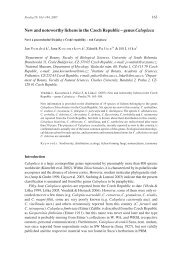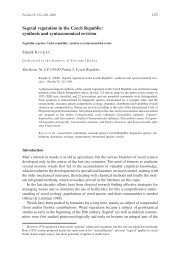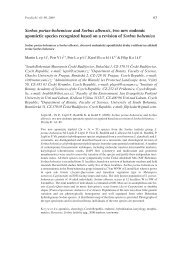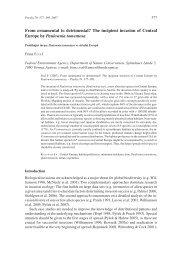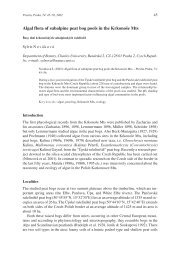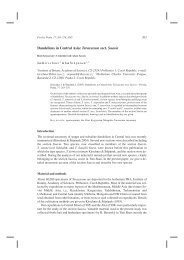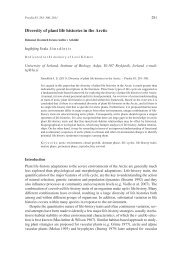Checklist and Red List of lichens of the Czech Republic
Checklist and Red List of lichens of the Czech Republic
Checklist and Red List of lichens of the Czech Republic
Create successful ePaper yourself
Turn your PDF publications into a flip-book with our unique Google optimized e-Paper software.
156 Preslia 80: 151–182, 2008<br />
Although <strong>the</strong>se <strong>lichens</strong> may be locally frequent, <strong>the</strong> loss <strong>of</strong> <strong>the</strong>ir habitats is continual <strong>and</strong><br />
evident, <strong>and</strong> <strong>the</strong>ir potential for dispersal is very limited. Species declining in abundance<br />
that occur also on human-made substrates are mostly included in <strong>the</strong> NT category.<br />
During a preparatory stage in <strong>the</strong> compilation <strong>of</strong> this <strong>Red</strong> <strong>List</strong>, changes in <strong>the</strong> distribution<br />
<strong>of</strong> certain species were studied in detail (Liška 1994, Liška et al. 1996, 1998a, b, 2006,<br />
Liška & Pišút 1990). For this study, threatened as well as rare <strong>lichens</strong> <strong>of</strong> various distributions<br />
in <strong>the</strong> <strong>Czech</strong> <strong>Republic</strong> <strong>and</strong> degree <strong>of</strong> sensitivity <strong>and</strong> frequency, were selected. These<br />
species were compared with o<strong>the</strong>r <strong>lichens</strong>, with similar distributions, sensitivities <strong>and</strong> potential<br />
threat <strong>of</strong> habitat change. These studies documented a notable decrease in sensitive<br />
species <strong>and</strong> significant changes in <strong>the</strong> distribution <strong>of</strong> <strong>lichens</strong> not regarded as endangered<br />
<strong>and</strong> <strong>the</strong>refore not red-listed before (e.g., Peltigera horizontalis <strong>and</strong> P. polydactylon). Detailed<br />
surveys <strong>of</strong> <strong>the</strong> distribution changes are published for only 36 <strong>lichens</strong>, but we were<br />
able to use our experience <strong>and</strong> <strong>the</strong>se results to evaluate o<strong>the</strong>r species.<br />
Of <strong>the</strong> IUCN criteria, criterion A (observed, estimated or suspected reduction in <strong>the</strong><br />
number <strong>of</strong> individuals) is currently impractical since <strong>the</strong>re is no information on population<br />
size at a particular locality. Therefore, indirect estimates were obtained for readily identifiable<br />
<strong>lichens</strong> with well documented past distribution. The decline was inferred from <strong>the</strong> reduction<br />
in <strong>the</strong> number <strong>of</strong> localities ra<strong>the</strong>r than individuals. This criterion is especially useful<br />
for taxa strongly associated with endangered habitats (old-growth forests, subalpine<br />
vegetation, peat-bogs, limestone outcrops) <strong>and</strong> used mainly in cases where <strong>the</strong> <strong>lichens</strong><br />
have been mapped in detail (Liška 1994, Liška & Pišút 1990, Liška et al. 1996, 1998a, b,<br />
2006). Criterion B (small geographic range <strong>and</strong> fragmented area <strong>of</strong> occupancy, continuing<br />
decline or extreme fluctuations in extent <strong>of</strong> occurrence, area <strong>of</strong> occupancy, number <strong>of</strong> locations<br />
or subpopulations or number <strong>of</strong> mature individuals) <strong>and</strong> criterion C (population<br />
size <strong>and</strong> continuing decline) are used for <strong>lichens</strong> with a specific ecology (e.g., cupro/ferrophilous,<br />
serpentinicolous <strong>and</strong> lichenicolous <strong>lichens</strong>) <strong>and</strong> species on <strong>the</strong> edge <strong>of</strong> <strong>the</strong>ir distribution<br />
area. Criterion D (small population size) is <strong>the</strong> main criterion <strong>of</strong> species that have<br />
very restricted distribution – last relict occurrences <strong>of</strong> <strong>the</strong> boreal-/arctic-montane species<br />
(e.g., Arctoparmelia centrifuga <strong>and</strong> Leptogium rivale), or rare species confined to specific<br />
habitats at one or a few localities, such as diabase <strong>and</strong> xero<strong>the</strong>rmic serpentine rocks (e.g.,<br />
Peccania cernohorskyi <strong>and</strong> Lichinella stipatula). In previous <strong>Red</strong> <strong>List</strong>s <strong>the</strong>se taxa were<br />
classified in category R (rare species). For o<strong>the</strong>r, mainly epiphytic species this criterion<br />
was used along with criteria A <strong>and</strong>/or C, e.g., in cases where <strong>the</strong> species are conspicuous<br />
but previously rarely recorded (e.g., Heterodermia speciosa <strong>and</strong> Lobaria amplissima).<br />
These taxa were placed in category CR. Criterion E (probability <strong>of</strong> extinction) is not applicable,<br />
because data for such an analysis are not available; extrapolation is possible only for<br />
epiphytic <strong>lichens</strong> where survival is dependent on <strong>the</strong> presence <strong>of</strong> a specific substrate (particular<br />
tree) <strong>and</strong> <strong>the</strong>y are unable to colonize new substrates.<br />
Strict application <strong>of</strong> category definitions would result in a high proportion <strong>of</strong> species in<br />
category DD. Including such taxa in <strong>the</strong> <strong>Red</strong> <strong>List</strong> would not increase its information value.<br />
Therefore, species were categorized even when <strong>the</strong> data were incomplete, by a comparison<br />
with better documented species. In addition, we tried to resolve <strong>the</strong> problems concerning<br />
<strong>the</strong> gaps in our knowledge <strong>of</strong> <strong>and</strong> changes in <strong>the</strong> <strong>Czech</strong> lichen flora by having discussions<br />
with o<strong>the</strong>r lichenologists. Never<strong>the</strong>less, changes in distribution have not been evaluated<br />
for some species with poor data, or where <strong>the</strong>re are uncertainties about <strong>the</strong> reliability <strong>of</strong> old<br />
records, <strong>and</strong> such species were included in <strong>the</strong> category DD (data deficient). Lichens for



